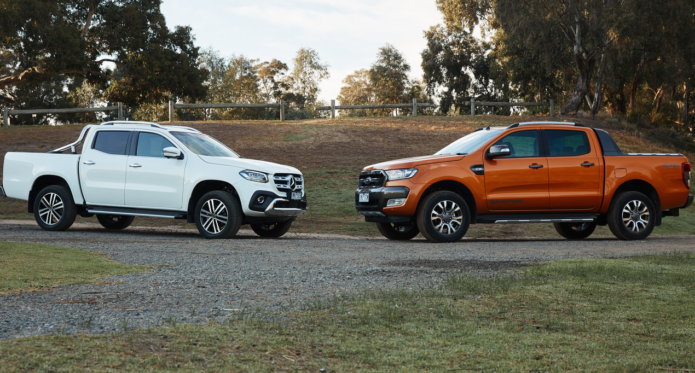Dual-cab utes have taken over the cities and suburbs of Australia. So much so that both the Toyota HiLux and Ford Ranger sit in the top-five most sold cars each year.
That popularity trend continues in other overseas markets, where the HiLux and Ranger also sell in huge numbers. Mercedes-Benz wants a piece of the premium ute mix and has dipped its toe in the dual-cab ute waters with the all-new X-Class.
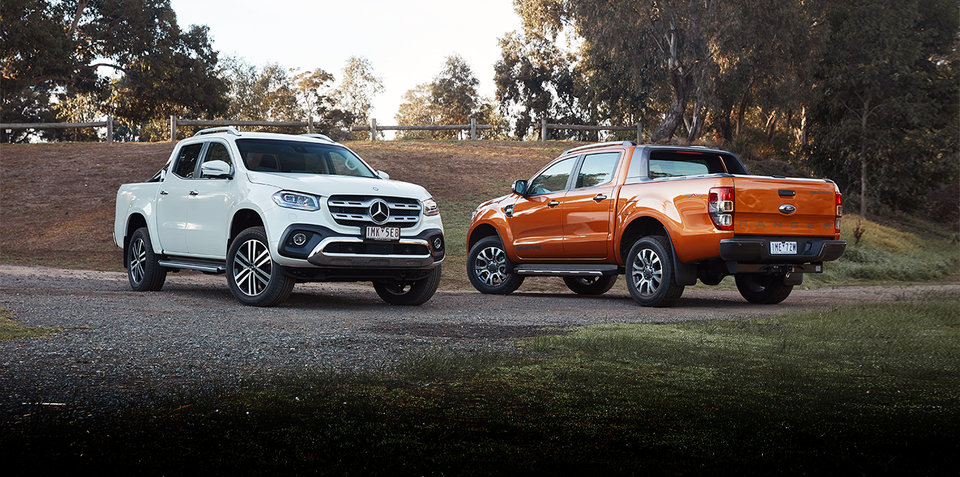
So, it only makes sense that we pit the top-specification Ford Ranger Wildtrak up against the current top-specification Mercedes-Benz X-Class X250d Power to see which should command your ute dollar.
While an update for the Ford Ranger has just been announced, which brings it to parity with the Mercedes-Benz for safety technology, the vehicle we have here is the PXII Wildtrak.
This comparison purely focuses on what these cars are like to drive in day-to-day duties. We’ll do a proper towing and off-road comparison down the track.
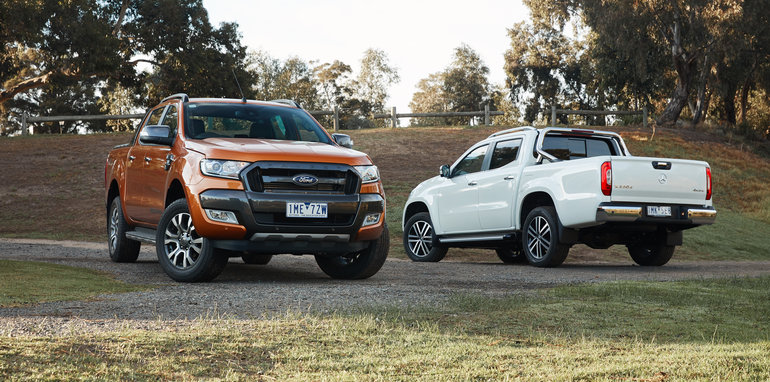
Pricing and specifications
The Mercedes-Benz X-Class is one of the most expensive dual-cab utes on the market. Based on the Nissan Navara, the X-Class range kicks off from $45,450 (plus on-road costs) for the 4×2 X220d Pure cab-chassis and runs all the way through to this specification, the 4×4 X250d Power, which is priced from $61,600 (plus on-road costs).
Mercedes-Benz offers customers a number of options they can add to their vehicle, with the one seen here featuring an additional $9240 of options, bringing the asking price to $70,840 (plus on-road costs).
The $2490 Style Pack includes privacy glass on the rear windows, electric rear window, side steps, roof rails, 19-inch six-twin-spoke light-alloy wheels, while the bed liner costs $899, the style bar an additional $1551, metallic paint for $950 and the seven-speed automatic gearbox for $2900.
Standard features fitted to the X250d Power include:
- 18-inch alloy wheels
- Seven airbags
- KEYLESS GO
- Active Brake Assist (AEB)
- Adjustable load-securing rail system
- Fog lamps – front
- Lane Keeping Warning
- Load bed lamp
- Dusk-sensing LED high-performance headlamps
- Tyre pressure monitoring
- Hill start assist
- Artico/Dinamica seat upholstery
- 360-degree surround-view camera
- Multi-link coil rear suspension
- Artico dash and door sill covering with contrast stitching
- ESP, ABS, ASR, EBD, BA, TSA
- THERMOTRONIC automatic climate control
- Electric front seats with lumbar support
- i-Size child seat anchorages
- COMAND navigation system
- PARKTRONIC park assist system
- Bluetooth connectivity
Key dimensions:
- Length: 5340mm
- Width: 2113mm
- Height: 1839mm
- Wheelbase: 3150mm
- Weight: 2161kg
- Payload: 1021kg
- Towing: 3500kg (braked), 750kg (unbraked)
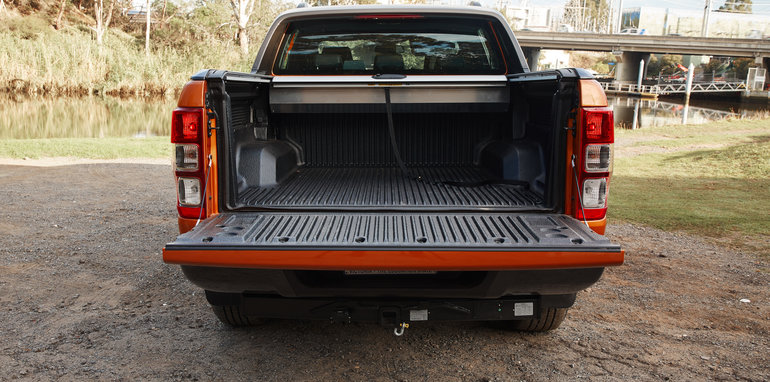
The Ford Ranger is priced from $27,690 (plus on-road costs) with the 4×2 XL Single Cab, with the top-specification Ranger Wildtrak priced from $59,590 (plus on-road costs). The vehicle seen here features a six-speed automatic transmission for $2200 and metallic paint for $550, bringing the total asking price to $62,340 (plus 0n-road costs).
Standard features fitted to the Ranger Wildtrak include:
- 18-inch alloy wheels
- Six airbags
- Adjustable load-securing rail system
- Closing and lockable tray cover
- Fog lamps – front
- Lane keeping assistant
- Load bed lamp
- Load bed accessory power outlet
- Halogen headlights
- Tyre pressure monitoring system
- Leather seats
- Hill start assist
- Reverse-view camera
- ESP, ABS, ASR, EBD, BA, TSA
- Dual-zone automatic climate control
- Electric driver’s seat with lumbar support
- ISOFIX anchorage points
- Sync3 infotainment with Apple CarPlay and Android Auto
- Satellite navigation
- Front and rear parking sensors
- Bluetooth connectivity
- Interior 230V power outlet
Key dimensions:
- Length: 5426mm
- Width: 1860mm
- Height: 1848mm
- Wheelbase: 3220mm
- Weight: 2289kg
- Payload: 907kg
- Towing: 3500kg (braked), 750kg (unbraked)
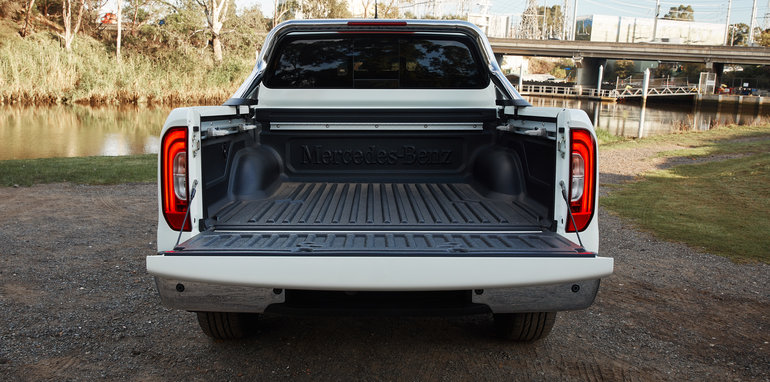
Interior
Given its premium price and brand cachet, you’d expect the Mercedes-Benz to deliver in terms of interior presentation and quality. The good news is, it absolutely does.
As you open the driver’s door, it’s a familiar design with the dashboard-mounted COMAND infotainment screen on display top and centre. The dashboard sweeps across the cabin and features a faux-leather stitched dashboard material. The doors close with a Mercedes-Benz-esque thud, and you’d be hard-pressed to realise you’re actually sitting inside a dual-cab work ute.
But, it’s let down by several cheap elements, such as the Nissan key, Nissan switchgear, some shoddy build quality around the rear of the headliner and a complete lack of storage. The COMAND ‘hovercraft’ takes up room normally reserved for cupholders, while the centre console is barely big enough for a wallet. There’s also nowhere to leave a phone, with the cupholder not wide enough for even a smaller iPhone.
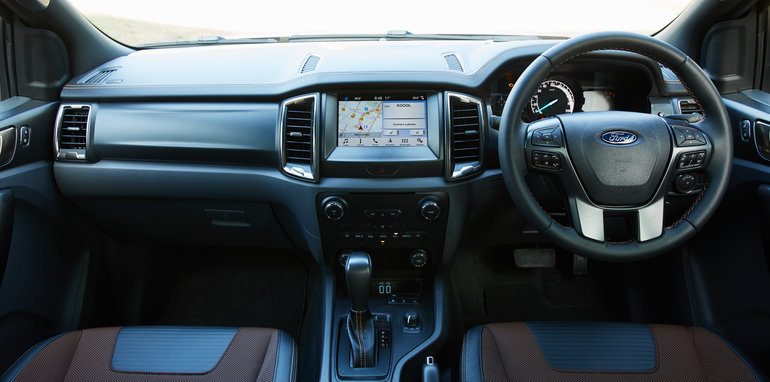
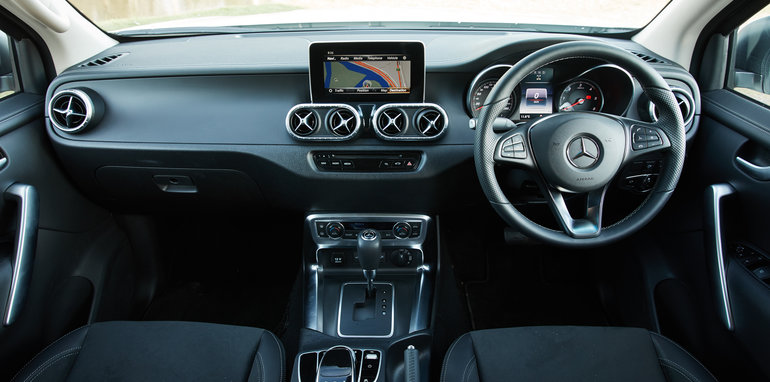
With that being said, the seats are very comfortable with plenty of adjustment and support for people of all shapes and sizes.
Leg and head room in the front row are great, as is visibility out the front and sides. It’s let down by a lack of leg and head room in the second row. Taller adults will find their heads pushed up against the roof with their knees contacting the seat in front. There’s plenty of width, though. In fact, the X-Class offers over 250mm extra width in comparison to the Ranger.
COMAND can be a bit confusing to use with a lack of touchscreen and logical menu structure. But, it’s backed by an easy to use voice-recognition system that works a charm.
The steering wheel sits beautifully in the hand and offers controls for the vehicle’s trip computer and excellent eight-speaker sound system.
Out the back, the 1021kg payload is backed by a tray width large enough to cater for a full-sized pallet. But, option the bed liner and that space is compromised slightly by the width of the plastic bed liner.
The Ranger, on the other hand, is getting on in terms of age. Originally launched as the PX in 2011, the vehicle received a facelift in 2015 with the PXII. The latest update is a very minor cosmetic update that brings with it the option of a new engine, but a predominantly unchanged interior.
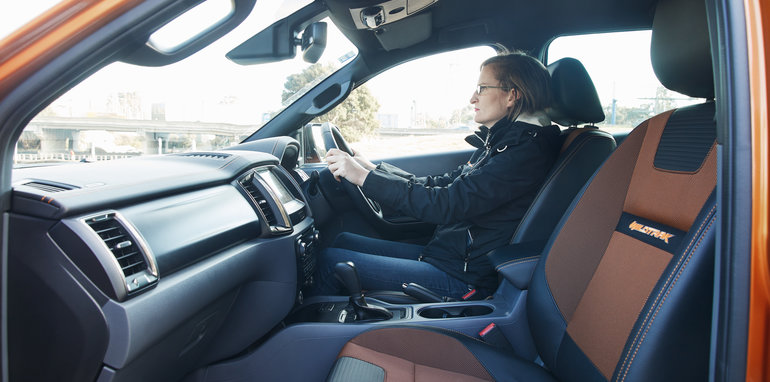
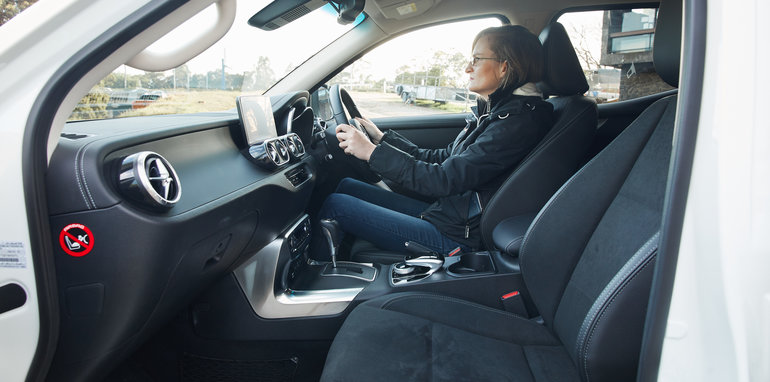
But with that in mind, it’s still a well-presented interior with all the hallmarks of a trade-friendly dual-cab ute. You’ll find plenty of storage between the driver and front passenger, ample in-door storage and a decent-sized glovebox.
Central to the interior is the Sync3 infotainment system. This is the best infotainment unit you’ll find in the dual-cab ute segment, with Apple CarPlay and Android Auto as standard, along with inbuilt satellite navigation and an excellent voice-recognition system.
The six-speaker stereo system is good, but not as good as the X-Class, and comes with DAB+ digital radio (as does the X-Class).
Ahead of the driver is a configurable instrument display that can be customised to display a range of vehicle information relating to the four-wheel-drive system or the trip computer.
Leg and head room up front are good, and it’s pretty good in the second row also. The second row lacks the air vents fitted to the X-Class, but it does come with a 230V power outlet. Leg room is great, as is head room, but it feels far narrower than the X-Class. If you put two adults side-by-side in the second row, you’d be hard-pressed to fit another person in the centre.
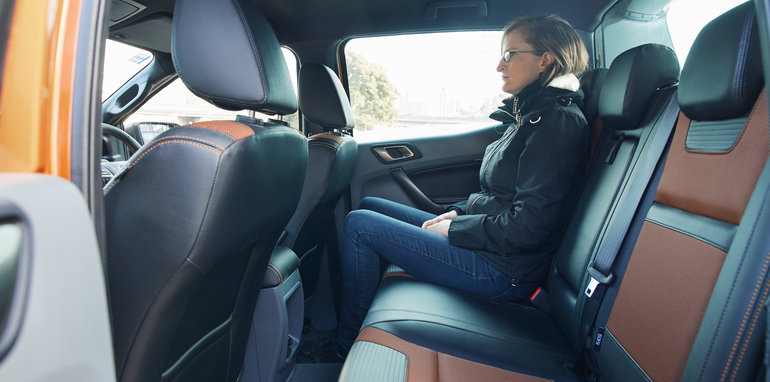
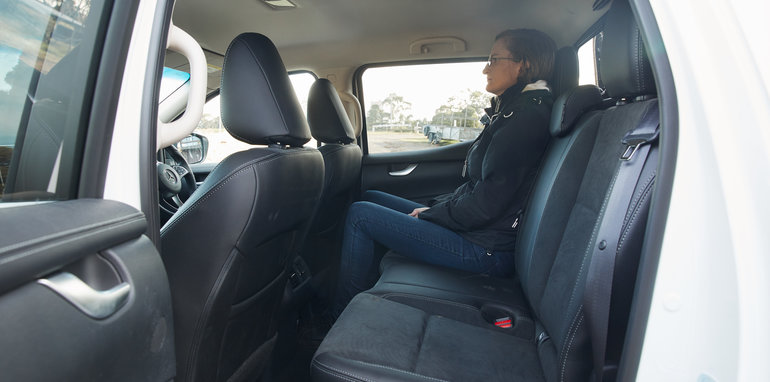
Given the extra kerb weight, the Ranger is let down by a shortfall in payload in Wildtrak trim. You’ll only be able to load 907kg into the tray, and it’s not wide enough to fit a pallet.
At the end of the day, both of these utes are likely to be driven by people that throw nothing more than a gym bag in the tray. But I’m glad to be corrected with any photo evidence to the contrary!
Unlike the X-Class, the Wildtrak is fitted with a garage door-style tray lid that slides back and can be locked. It’s a versatile system and works pretty well for covering valuables.
On the road
Under the bonnet of the X-Class is a Nissan Navara diesel engine with identical power and torque outputs. It’s a 2.3-litre twin-turbocharged diesel engine that produces 140kW of power and 450Nm of torque, and mated to a seven-speed automatic gearbox.
Drive is normally sent to the rear wheels, with a low- and high-range four-wheel-drive mode available. But, like the Ranger, the four-wheel-drive mode can only be used on unsealed surfaces to prevent drivetrain damage.
Fuel consumption is pretty impressive, rated at a combined 7.9 litres of fuel per 100km. And, you’ll expect to hit that figure if you chew up highway miles like we did. We averaged 8.2L/100km over around 1000km of driving with predominantly highway kays.
As you set off in the X-Class, one of the things you will immediately notice is how quiet it is. The Navara’s diesel engine is quite noisy, especially when accelerating. You can barely hear a whisper inside the X-Class, and it’s the same story when it’s on the move. It’s damn impressive what they’ve been able to do with extra sound-deadening.
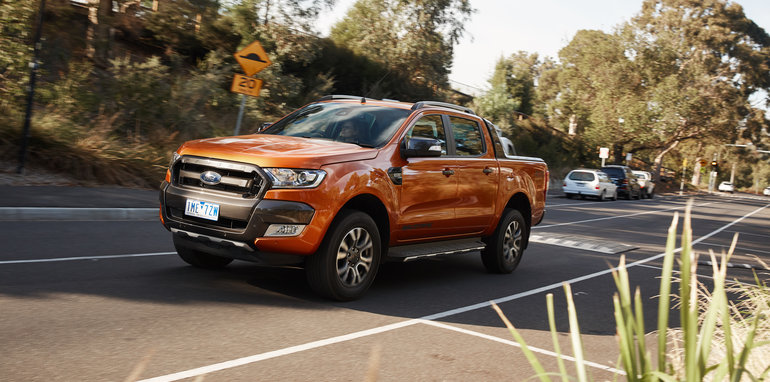
Arguably the biggest difference you’re going to notice is the ride. Despite sitting on 19-inch alloy wheels, Mercedes-Benz has done a considerable amount of work on re-engineering the five-link coil-sprung suspension fitted to this chassis.
Mercedes-Benz has engineered a sportier feel that offers a slightly firmer ride, which allows the front and rear to feel more connected. Often with the Navara you can hit a bump at the front, only to have it feel a little more abrupt at the rear, and that can unsettle the car with a load.
The X-Class, on the other hand, deals well with bumps and feels plush in and around the city. Head out to the country on unforgiving corrugated roads and it keeps up the performance, offering ride compliance and a retention of body control and feel through the steering wheel.
It can get a little bumpy and rigid over corrugated sections of sealed road, but it’s nothing to write home about. The Mercedes-Benz engineers have done an excellent job with this chassis.
Where it really takes the game to the next level is on the handling front. While it’s partly helped by road-oriented Bridgestone Dueler tyres, similar to those fitted to a Range Rover Sport, the body control is excellent.
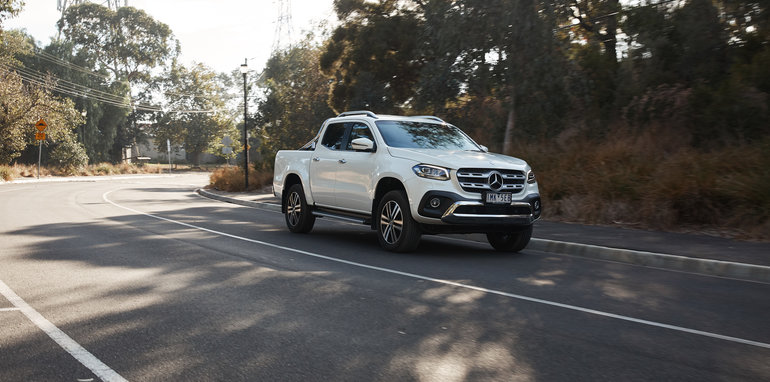
It sits flat through corners and delivers a driving experience not yet seen in the dual-cab ute segment. There’s also plenty of feel through the steering – it’s on the heavier side of comfortable, but gives you the feeling of sportiness, which is what the Mercedes-Benz team was after.
Unfortunately, the package is let down by the diesel engine under the bonnet. While it’s good at low speeds, it runs out of puff very easily and can feel quite laggy if you catch it off-guard.
Overtaking can feel particularly underdone out in the country. If you’re already travelling at 100km/h and need to overtake, it needs commitment and planning, as opposed to just stepping on it and riding the torque wave.
One of the other key differences here is the inclusion of rear disc brakes. They bring an exceptional brake pedal feel and give you the confidence to ride the brake for longer – this would be particularly handy when carrying a load in and around the city.
At the end of the day, these cars will spend most of their time in and around the city. That’s where the hydraulic steering system is a bit of a letdown. It’s too heavy for low-speed driving and can be a bit of a pain when trying to get into a tight park.
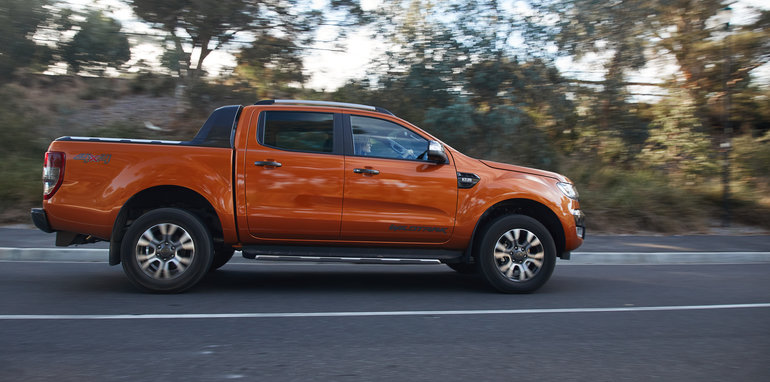
It also means that it misses out on a semi-autonomous parking feature or a lane keeping assistant, both which require electrically assisted steering.
On the parking front, the 360-degree camera is excellent. The clarity is next-level and it can be adjusted to offer different views of the car on demand.
Over in the blue corner, the Ranger Wildtrak offers a predictable package.
Under its bonnet is a 3.2-litre five-cylinder turbocharged-diesel engine that produces 147kW of power and 470Nm of torque. It’s mated to a six-speed automatic gearbox with a low- and high-range four-wheel-drive system. The low- and high-range systems can only be used on low-friction unsealed surfaces. Fuel consumption comes in at 8.9L/100km. On test, we achieved a little under 10L/100km.
The engine is loud, but it sounds gruff and tough. It definitely has the edge over the X-Class, and that’s thanks to the unique-to-this-segment five-cylinder configuration (not counting the Mazda BT-50, which shares the Ranger’s platform).
Throttle sensitivity in the Ranger is very different to the X-Class. It’s sensitive and ready to push the Ranger forward at the drop of a hat. It takes a little bit of time to get used to, because it can surge the car forwards if you hit the throttle a little too hard.
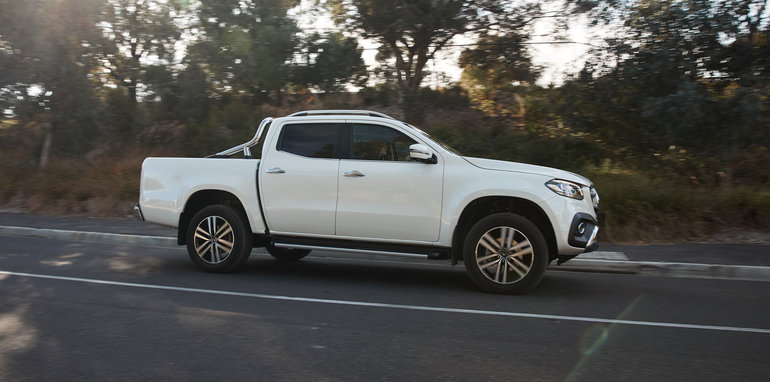
Inside the cabin, it’s also noisier than the X-Class. That will be an ultimate consideration for buyers. Despite the noise being suitable for the car, it may be a bit much for some people.
Using an electrically assisted steering rack, the Ranger offers superior steering feel and ease of use at low speeds. The latest Ranger Wildtrak update includes semi-autonomous parking, plus the AEB feature set currently fitted to the X-Class.
While it misses out on a coil-sprung suspension set-up and relies on leaf springs, the local ride and handling tuning are exceptional. It takes the Ranger to the top of the pile in terms of ride in and around the city, and out in the country.
Ford sacrifices payload with the Wildtrak’s suspension set-up, but the benefit is a ride that’s on the firmer side of comfortable out in the country when unladen, but progressive and cushy when laden.
From the driver’s seat, there’s a feel of ultimate control over the vehicle in terms of seating position and visibility out of the cabin. Both the X-Class and Wildtrak don’t offer telescopic steering adjustment, but it’s not an issue – the seating position in both lends itself to every driver we’ve thrown in them, both tall and short.
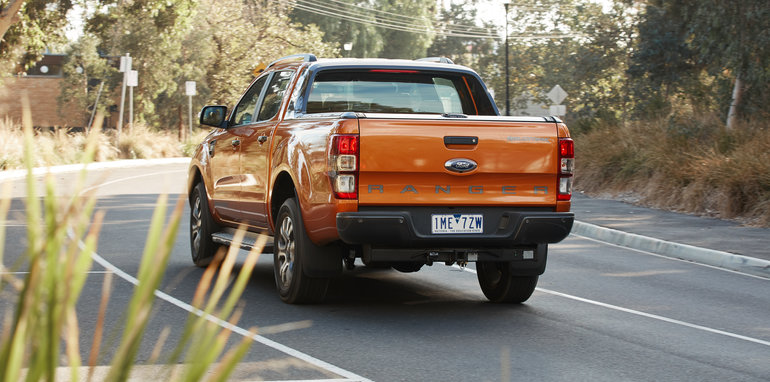
Throttle response at speed is excellent, with the gearbox doing a stellar job of selecting the right gears when they’re required. But it’s let down by a lack of punch at highway speeds and when you call on full throttle.
That’s partly due to the kerb weight of some 2289kg – compared to the X-Class, which also feels undercooked, that’s 205Nm/tonne in the Ranger and 208Nm/tonne in the X-Class.
The Ranger also lacks the corner-eating appeal of the X-Class, with the Ranger more keen to step out sideways before the X-Class when punted through corners. You can thank the extra width for that planted feel on the road.
Despite missing out on rear disc brakes, the pedal feel and brake performance of the Ranger are top-notch. You can only really tell the difference after repeated hard stops.
It’s worth noting here that 99 per cent of owners are unlikely to ever hunt down a set of bends for a weekend punt. But, we’ve tested these cars to verify manufacturer claims and to determine whether the ultimate cost difference is really worth it.
One thing worth pointing out is headlight performance. The X-Class uses LED headlights that work incredibly well at night time and in the country. That’s compared to the Ranger, which uses halogen headlights that are quite dull and lack night-time performance. This changes with the recent Ranger update, which adds LED headlights.
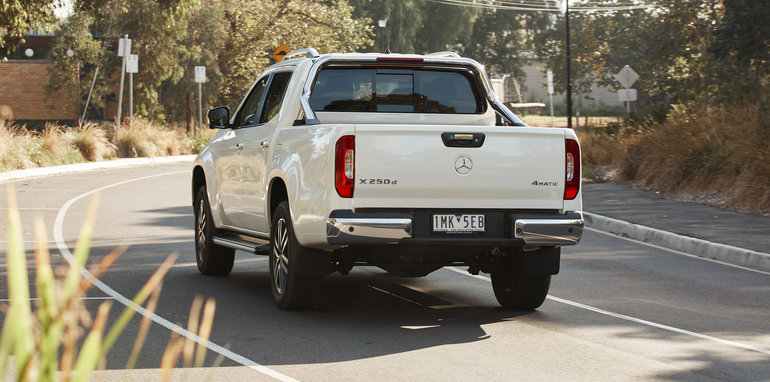
Ownership
Mercedes-Benz trails Ford in terms of warranty and ownership costs. The X-Class comes with a three-year, 200,000km warranty with 12-monthly, 20,000km service intervals.
Over three years, you can buy a ServiceCare Plan for $1850 covering three scheduled services, saving you $500 over the term. The individual visit costs of $585, $930 and $835 are high for the class (Navara’s costs are $547, $571 and $714). If you don’t prepay, you’ll be up for $2350 over three years.
Ford, on the other hand, offers a five-year, unlimited-kilometre warranty with 12-monthly, 15,000km service intervals. Over three years, the Ranger costs $1475 to service. The individual costs are $400, $570 and $505.
Both vehicles use a diesel particulate filter (DPF). It’s worth taking that into account if you’re only travelling in and around the city. Both require occasional highway drives to regenerate the filtration system.
VERDICT
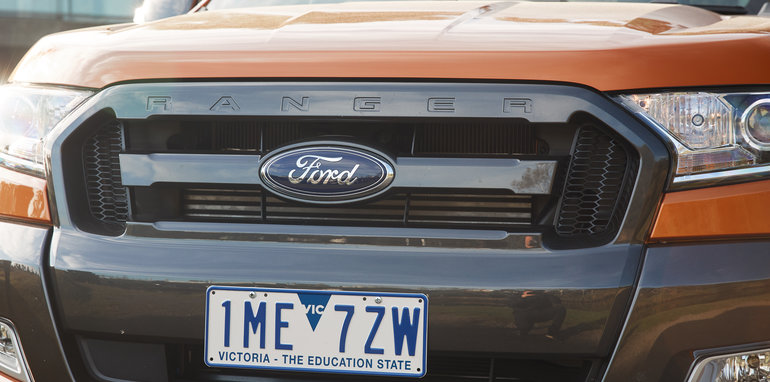
I was genuinely surprised with the Mercedes-Benz X-Class. I was expecting just a Navara, but it surprised with attributes one would consider a Mercedes-Benz product to have.
But, it’s let down by small things like the Nissan key and some build-quality questions. One of the most ridiculous things with the key, however, is that a note on the instrument cluster reminding you to take the key with you shows a picture of a Mercedes-Benz key.
The Ranger continues to impress. Despite its age, the engine is a pearler and it presents a well-finished cabin with all the latest technology and equipment.
The recently announced upgrade to features and the introduction of a 2.0-litre diesel engine simply cements this as the smarter purchase choice.
Ultimately, the nail in the coffin for this comparison is the price. There is no conceivable place where the X-Class feels like it’s worth almost $10,000 more than the Ranger. In fact, we’d get the XLT and simply pocket a bigger $10,700 difference when it’s fitted with equivalent features.
Where this equation will change is when the X-Class V6 diesel arrives. It will offer a Mercedes-Benz drivetrain in a chassis that has been built for driving enjoyment.
We can’t wait to put this to the test, and see how it stacks up against the Ranger and the other segment leaders.
PHOTOS : https://www.caradvice.com.au/649578/2018-mercedes-benz-x-class-x250d-power-v-ford-ranger-wildtrak/photos/
(caradvice.com.au, http://bit.ly/2kpUHL5)


